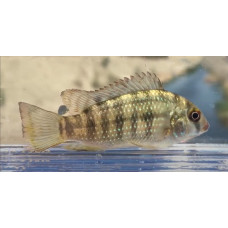Latin name
Coptodon zillii, tilapia zillii.
Other name
Zille's redbreast tilapia or St. Peter's fish.
Identification
Large species with a dense build, narrow head and small strong jaws. The upper profile of the head is not convex. Lower pharyngeal jaw as long as wide and anterior plate shorter than premaxilla; median pharyngeal teeth not expanded.
Features of fish fins
Dorsal spines (total): 13 - 16; Dorsal soft rays (total): 10 - 14; Anal spines: 3; Anal soft rays: 8 - 10.
The dorsal and caudal fins of redbelly tilapia are absent or poorly colored.
Fish colouring
The body of the fish is brownish-olive with an iridescent blue sheen, without forked dark vertical stripes on the sides. When excited, they have a longitudinal dark stripe on the flanks. Breast pinkish, dorsal, anal and caudal fins brownish-olive with yellow spots on the dorsal and anal fins is also a narrow orange border. The pelvic fin is yellowish or grayish without spots in young individuals, and usually darkens with age and is covered with growing spots. The characteristic "tilapia" spot is wide and covers the area from the last spine to the fourth soft ray of the dorsal fin. There is always a yellow stripe adjacent to the spot. The lips are bright green.
Distribution
The redbelly tilapia inhabits waters in Africa (Southern Morocco, Sahara, Niger-Benue system, Senegal, Sassandra, Bandama, Bubo, Me, Comoé, Bia, Ogun, Osun, Ubangi, Ouele, Aruvimi, Itimbiri, Middle Congo Basin, Volta System, Chad-Chari System, Lakes Albert and Turkana, Nile System) and southwestern Asia (Jordan River Basin) between 35°N and 10°S with mean water temperatures ranging from 11 to 36 °C (maximum range 6.5-42.5 °C). N and 10°S with mean water temperatures between 11 and 36°C (maximum range 6.5-42.5°C). Introduced into U.S. waters (Arizona, California, Texas, North and South Carolina, Hawaii, possibly Florida and Nevada).
Habitat
The fish leads a demersal lifestyle in fresh or brackish (salinity up to 45 ‰) waters, usually at depths from 1 to 7 meters, preferring areas with aquatic plants. Fry are often found near the edges of dense vegetation, juveniles - in areas of seasonal flooding.
Size
The standard length (excluding the caudal fin) of these fish is 30 cm, but specimens up to 40 cm have been reported. Maximum known body mass is 300 g, maximum known age is 7 years.
Behavior
Redbelly tilapia are mostly diurnal. They sometimes form schools.
Food and feeding habits
Herbivorous, adults feed on leaves and stems of underwater plants, algae, and plant detritus; invertebrates are also included in the diet.
Reproduction
This species breeds throughout the year (at temperatures of 20°C and above) and can produce several clutches of eggs per year. Females lay sticky eggs - up to 1000 eggs at a time - on the bottom of the water in areas with small stones or sand and dense vegetation on the substrate. Both parents will then guard the clutch. Hatching occurs about 96 hours after spawning, and the young swim freely after about 4-6 days. The larvae develop in close association with the substrate.
Fishing
Redbelly tilapia is an economically important commercial and aquarium fish, and in many places is bred to control overgrowth in waterways.
Relationship with a person
Potential pest. In several countries, the introduction of this species has had a negative impact on the ecology of water bodies.
| Classification | |
| Phylum | Chordata |
| Class | Actinopterygii |
| Squad | Cichliformes |
| Family | Cichlidae |
| Genus | Coptodon |
| Species | C. zillii |
| Features | |
| Conservation status | Least Concern |
| Habitat | Demersal |
| Life span, years | 7 |
| Maximum body weight, kg | 0,3 |
| Maximum length, cm | 40 |
| Sailing speed, m/s | No information |
| Threat to people | Edible |
| Way of eating | Planktonophage |
Redbelly tilapia
Tags: redbelly tilapia

